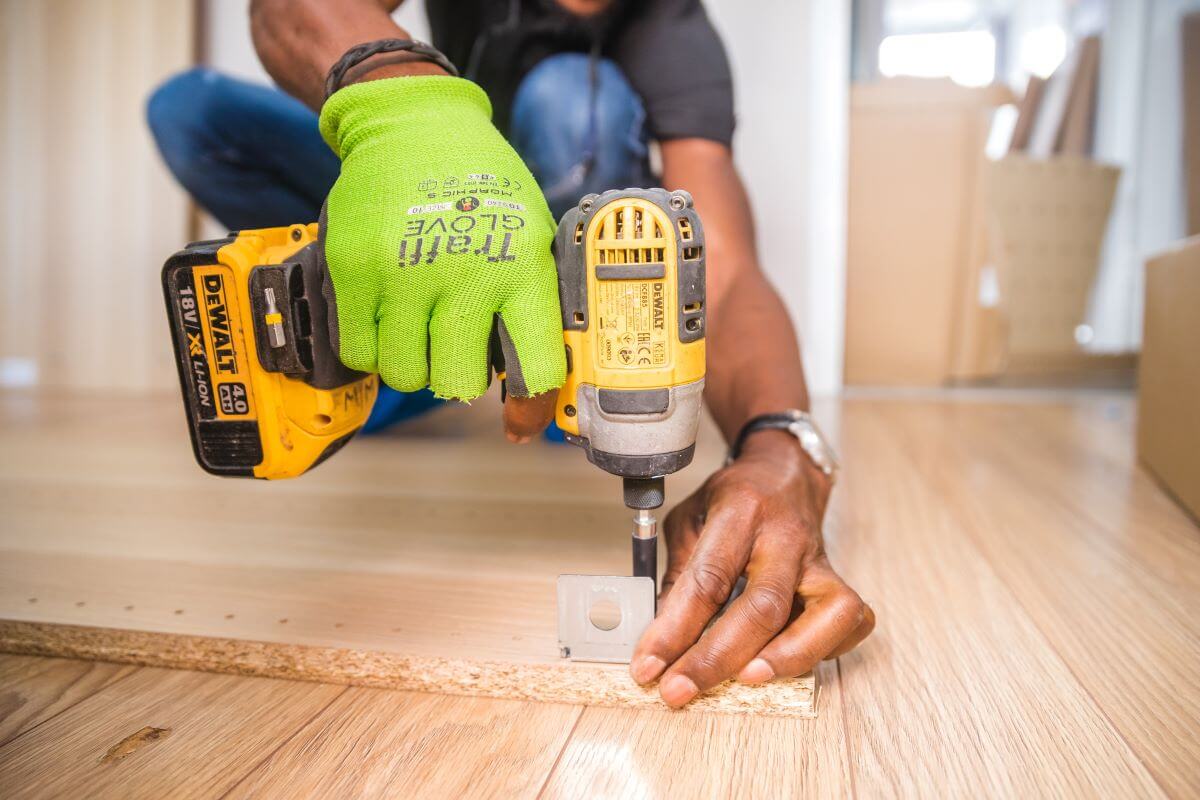This article explains how to become a handyman, and how to start a handyman business so you can put your skills to work!
When something needs done around the house, is your name the first on the lips of friends and family? They may have even nicknamed you the “fixer” or “jack of all trades”. Well, what if you could make a profit from your impressive range of skills?
From minor repairs to extensive DIY projects, if you’re good at fixing things and skilled with your hands, learning how to become a handyman might be your calling.
Don’t know where to start? Keep reading to learn how to become a handyman. Better yet, you’ll learn how to start a handyman business to translate your passion into a lucrative income stream.
What does a handyman do?
Before explaining how to become a handyman, it’s important to first understand what a handyman does.
A handyman is a person that is skilled at a wide range of repairs. These repairs are usually around the house, although some handymen find themselves working in more commercial settings.
Just like general contractors, handymen take on many different types of work. Let’s take a look at some of the most popular jobs you might face as a handyman.
Types of handyman work
Learning how to become a handyman requires you to understand the services you can offer, and there’s no limit to the types of work that a handyman can do.
Here are some of the top jobs that you should consider in your future handyman work.
Painting
If you already consider yourself a handyman, chances are that you’ve had to complete a paint job before.
Paint jobs are one of the most common handyman jobs around, and they are typically the simplest ones too.
Painting makes a great first handyman service to advertise to customers for several reasons:
- Not too much equipment is required.
- It can be done with basic skills.
- There are minimal licenses and legal requirements compared to other trades.
In short, if you want to learn how to become a handyman, learning how to paint is essential.
That said, painting can be more physically challenging than other trades, so you want to ensure that you’re up for the challenge before you make it a core offering to your customers.
Floor repairing
Floor installation and repair take specialized skills. However, it is a job that is highly in demand, and one that many people refuse to undergo themselves.
However, while some states allow you to repair floors without special accreditation, others require a special license or training to qualify for undertaking floor repairs.
Furniture assembling and restoring
Many handymen’s first jobs involve furniture assembly and repair. As a professional handyman, you can expect these jobs to continue to come your way.
A handyman builds and repairs large and small home furniture in various ways. These tasks range from building IKEA furniture to polishing and restoring antique furniture.
Gutter cleaning
While experts recommend that you clean your gutters at least twice a year, many people overlook this crucial home task.
As a handyman, you can educate people as to why gutter cleaning is so important, in addition to actually cleaning their gutters as part of your services.
Power washing
Power washing involves using a high-pressure stream of very hot water to blast away dirt and materials from outdoor surfaces.
Unfortunately, not many own a power washer, nor know where to get one or how to use it. This is where your handyman services come in. With your help, your customers get the effects of power washing without having to pick one up themselves.
While this variety of work available to handymen is appealing, it’s important to assess both the good and bad aspects of the job to ensure that you make the right decision. This is especially important if you’re seeking to learn how to start a handyman business.
Let’s walk through the pros and cons of pursuing how to become a handyman and starting your own business.
Pros and cons of starting a handyman business
Breaking into the handyman industry is simple if you already have the skills, but running a successful handyman business can be a challenge.
To illustrate, here are the pros and cons of learning how to become a handyman.
Pros of starting a handyman business
- You’re less likely to get bored since every day is a different job.
- You can start your business part-time.
- With most jobs being small, your overhead costs are low.
- You’re self-employed and can make your own hours.
- You’re more likely to get word-of-mouth referrals.
Cons of starting a handyman business
- The job is physically demanding.
- Fulfilling license requirements in your area may prove to be an obstacle.
- You need a wide range of knowledge in home repair, maintenance, and construction starting up.
- If you don’t already have good work tools, you need to invest in some.
- Building a customer base may take some time.
Still want to turn your handyman skills into a profit? Let’s jump into how to start a handyman business.
How to start a handyman business
Learning how to become a handyman is one thing, but figuring out how to start a handyman business is a whole different ballpark.
Don’t worry, we’ve got you covered. Below is a guide on how to kickstart your handyman business in 6 steps.
Step 1: Get licensed
Before you do any work as a professional handyman, you must ensure that you have all of the licenses required in your area.
For the most part, handymen doing small jobs don’t typically need any educational qualifications. That said, it doesn’t hurt to have some official training. You may consider:
- Taking a short college course.
- Doing an apprenticeship.
- Volunteering with local organizations.
Finally, you need a business license for your handyman business. Check with your state to learn how to register your business and other requirements.
Step 2: Draft a handyman business plan
The next step in learning how to start a handyman business is drafting a business plan.
A business plan is important if you’re looking to get a loan, but also helps you organize your business goals.
Here are some things to include in your business plan:
- Current industry analysis.
- Details on potential customers and competition.
- Projected business expenses.
- Business insurance.
You’ll also want to have a plan for administrative tasks such as payment processing and accounting. For example, you should consider whether it’s better to use QuickBooks or Xero for contractor and handyman work.
What’s more, this is the time to decide whether you’ll focus on commercial or residential clients, so that you can form a successful marketing strategy.
Step 3: Purchase tools and equipment
A handyman is only as good as their tools. Investing in proper tools is non-negotiable when figuring out how to start a handyman business. They show your customers that you’re professional, and make the overall job much easier.
Tools that you need to start up include:
- Painting supplies.
- Power tools.
- Tool belt.
- Electric drill.
- Tape measurer.
Step 4: Set your rates
Having a profitable handyman business often comes down to how much you charge. Setting your rates is a crucial but confusing step in figuring out how to start a handyman business.
To determine your hourly rate, check out what your competition is charging in your area. This will also help you choose whether to charge handyman prices by the job or at an hourly rate. From there, you need to determine a rate that is competitive, yet will still result in profit.
Step 5: Reach your customers
As a new handyman business owner, the only way to grow your business is to get your name out there.
To market your business, the first thing you should do is create a website. Your website should advertise your handyman services and reflect your brand.
Other ways to market your business include:
- Social media.
- Email marketing.
- Fliers around your area.
- Word of mouth.
Step 6: Create lasting customer relationships with Method CRM
What do you do once you have a successful business? Figure out how you’re going to keep it that way and surpass your goals. This requires you to understand that your customers are your priority, and therefore need to be your focus.
However, in today’s modern world, it’s difficult to keep track of your customers and all other aspects of your business by yourself. That’s why software is essential in staying organized and maximizing efficiency.
If you’re looking for the best handyman software, Method CRM has you covered. With Method, you can combine your workflows into one place, from creating estimates to payment processing.
This centralized hub makes it easier to serve your customers’ needs, and thanks to Method’s mobile app, you can serve those needs while on the go.
Here are Method’s top features for your handyman business:
- Two-way QuickBooks and Xero sync so your information is always up to date.
- Gmail and Outlook integrations to save emails to your CRM without leaving your inbox.
- Web-to-lead forms to capture website traffic.
- Online customer portals to streamline communication.
- Payment gateways such as Stripe and Paypal for your customers’ convenience.
How to become a handyman FAQs
What type of work can a handyman do legally?
A handyman can do all types of work legally. Handymen primarily do repair and maintenance jobs.
In general, there’s no “handyman license” required to work as a handyman. All you need to do is learn how to become a handyman through formal or informal training to develop the necessary skills.
However, there are limits to the repairs a handyman can do. For example, handymen cannot do major repairs on home electrical or plumbing systems, as those require specialized skills and qualification.
How much does it cost to start a handyman business?
The cost of starting a handyman business depends on several factors, including:
- Your location.
- The handyman services you offer.
- The tools you require.
- Cost of liability insurance.
However, the startup costs of a handyman business are lower than other types of businesses, and usually range from $2,000 to $6,000.
How much do handymen charge?
According to Home Guide, the average hourly rate for a handyman ranges from $50 – $80, plus the cost of materials.
Some handymen don’t charge an hourly rate, and instead charge by the job. Most handymen charge for a minimum number of hours or a minimum set price.
How much does a handyman business make?
According to Thimble, handymen made between $25,000 and $75,000 in 2021.
The amount of money you can make increases as you grow your business and become more efficient. Reinvesting in your business through marketing materials and software will likely increase your revenue and, as a result, your profits.
Recap: How to successfully start your handyman business
Now that you know how to become a handyman, and how to start a handyman business, you’re ready to launch your new career.
Keep in mind that being a handyman and a business owner require different sets of skills. And wearing both hats takes twice the amount of time. While it’s possible to do both, you may need a little help with getting your business up and running and maintaining your success.
Software is the best way to stay on top of your daily business tasks, so that you can get more jobs done.
Method CRM gives you the tools to jumpstart your business. Watch the demo now.
Image credit: Bidvine via Pexels






